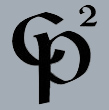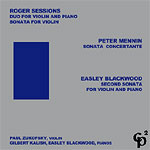
DUO FOR VIOLIN AND PIANO
SONATA FOR VIOLIN
PETER MENNIN
SONATA CONCERTANTE
EASLEY BLACKWOOD
SECOND SONATA
FOR VIOLIN AND PIANO
PAUL ZUKOFSKY, violin
GILBERT KALISH, EASLEY BLACKWOOD, pianos

 |
ROGER SESSIONS DUO FOR VIOLIN AND PIANO SONATA FOR VIOLIN PETER MENNIN SONATA CONCERTANTE EASLEY BLACKWOOD SECOND SONATA FOR VIOLIN AND PIANO PAUL ZUKOFSKY, violin GILBERT KALISH, EASLEY BLACKWOOD, pianos |
 |
ROGER SESSIONSRoger Sessions' Duo for Violin and Piano, composed in 1942, is set in one continuous movement. The opening "Andante moderato, tranquillo ed espressivo" is a prelude to an explosive "Allegro impetuoso." The initial "Andante" returns for a brief reminiscence, and after a moment of hesitant expectancy, the music rushes into a fiery "Allegro vivace e con fuoco." The texture throughout the work is robust and dissonant, tonal but constantly in flux. Each principal section maintains a strong rhythmic pulse, mostly in passages of eighth-notes and in eighth-note triplets, until the finale in which rapid motion in sixteenth-notes is prevalent. Considering the uncompromisingly dissonant idiom of the music, it is interesting that Sessions chooses to use definite key signatures, four flats, followed by five sharps and returning to four flats again, even though he is compelled to cancel the prescribed flats and sharps time and again as the musical current departs from the set tonality. The finale bears the key signature of one sharp, and the ending on the descending fifth in the bass of the piano part seems indeed to suggest the key of G major. In fact, the interval of a perfect fifth in downward motion is of thematic importance in this Duo. Some Ph.D. aspirant ought to write a thesis entitled, "The role of the descending perfect fifth in the tonal structure of the music of Roger Sessions." My Sonata for Violin was written during March and April, 1953, in Berkeley, California, where I was living and working at that time. Robert Gross, an old friend and a very fine violinist, had written me suggesting that I write such a work, and my first intention was to answer him immediately with a flat "No." A piece for a solo stringed instrument seemed to me quite at variance with my own musical impulses at the time; though I knew, and loved, the Bach Solo Sonatas and 'Cello Suites, the only contemporary work of the kind which I had heard was the 'Cello Sonata of Zoltan Kodaly, which struck me by its mastery and its brilliance, but which did not tempt me as a model for a work of my own. Above all, I am not a string player. Though I had written large works for violin both with orchestral and piano accompaniment, I had in each case first class violinists among my friends, on whom I could call for advice at any moment. The problem of writing a Solo Sonata seemed to me a much more formidable challenge; and Mr. Gross, for whom the work was to be written (and to whom it is dedicated) lived in Los Angeles, some four hundred miles from Berkeley! However, I am a bad correspondent, and did not answer Mr. Gross immediately; and to my surprise I found myself quite idly toying mentally with fragments of violin music, which one day took real shape in the series of seven rising tones with which the Sonata opens. At that point I realized that I was about to write the piece after all. After finishing a first draft of the first movement, I visited Mr. Gross at his home in Los Angeles, and his technical advice and suggestions proved invaluable to me. He also performed the first three movements of the Sonata in San Francisco late in that spring, and the complete work during the following season. I was also in for another surprise. Though I had been for many years familiar with the music of Schoenberg, Berg, and Webern, and more recently Dallapiccola, I had made up my mind that, at the age of more than fifty, I did not wish to undertake to master what looked to me like a whole new technical discipline. I had, as a matter of self-instruction, studied these works, and had carried out brief and quite trivial exercises of my own. It was only after I had composed the first five or six measures of the Sonata that I realized that my music was proceeding naturally along "twelve-tone" lines, and realized that this was an inevitable consequence of the fact that the opening idea, consisting of a group of seven tones, followed by a complementary group of five, had set up a pattern which made its treatment as a tone-row the most natural course to follow, in this movement at any rate. I planned not to mention this fact to anyone; but a younger colleague, to whom I showed the completed draft of the first movement, discovered it immediately. After reading the movement through to the end, however, he remarked, with implied surprise, "But it's still your music" - which is after all the essential point. The twelve-tone treatment is used only episodically in each of the three movements which follow the first. I have never felt that my use of it at that time was what is called a "big deal." I would add my conviction that no one who has not used it in his own work can fully understand its nature. As my own music continued developing after the Violin Sonata, I found myself using it at first very sparingly and with entire freedom, as one of many compositional resources which, however, revealed themselves to me more and more richly as my work progressed. I have never regarded it as either a slogan or a cause - least of all, a crutch, for which it is quite ill-fitted. The Sonata consists of four movements, ideally to be played without pause. The first movement, with the indication "Tempo moderato, con ampiezza, e liberamente," is rhapsodic in character; it consists of three contrasting episodes, of which the second is most animated. Each episode is introduced by a variant of the opening phrase of the movement - rising briefly before the second episode, falling from the high register before the third, and at length, in very slow tones, at the close. The second movement, "Molto vivo," embraces three sections, of which the third is virtually an exact repetition of the first - the only complete instance of this procedure in all of my music, but one which seemed thoroughly appropriate here. The middle, contrasting section - "un poco meno mosso, ma sempre appassionato," - is somewhat more rhapsodical in character. The third movement, "Adagio e dolcemente," brings four statements, each time a little more expansive, of the idea with which the movement opens. These statements are separated from each other by declamatory passages ("quasi recitativo"), each in its turn more expansive than the preceding one. The fourth statement of the principal idea develops into a freer melodic line, and closes with a foreshadowing, three times repeated, of the opening notes of the last movement. The final movement, "Alla Marcia vivace," is the shortest of the four. The quick march rhythm gives way, towards the middle of the movement, to a short contrasting passage in 3/4 time; it then returns, somewhat more elaborately, leading to a quiet passage, recalling the rhapsodic mood of the first movement. The whole closes with a very brief reference to the opening measures of the "Alla Marcia." The above notes are aimed to give a few indications to help the listener to orient himself while he is still unfamiliar with the piece, and in no sense [are] a guide to impressions which only familiarity with the music itself can yield. RS
|
||||||||||||||||||||||||||||||||||||||||||||||
| TRACK LISTING |
|
| Roger Sessions: DUO FOR VIOLIN AND PIANOLISTING |
|
| 1. Andante moderato, tranquillo ed espressivo | (3:37) |
| 2. Allegro impetuoso | (4:41) |
| 3. Andante | (2:02) |
| 4. Allegro vivace e con fuoco | (4:05) |
Time = 14:25 |
|
Roger Sessions: SONATA FOR VIOLIN |
|
| 5. Tempo moderato, con ampiezza e liberamente | (9:09) |
| 6. Molto vivo | (4:45) |
| 7. Adagio e dolcemente | (7:31) |
| 8. Alla marcia vivace | (3:15) |
Time = 24:39 |
|
Peter Mennin: SONATA CONCERTANTE |
|
| 9. Sostenuto - Allegro con brio | (4:58) |
| 10. Adagio semplice | (4:42) |
| 11. Allegro con fuoco | (3:55) |
Gilbert Kalish, piano Time = 13:46 |
|
Easley Blackwood: SECOND VIOLIN SONATA |
|
| 12. Andante | (7:16) |
| 13. Con moto | (8:15) |
| 14. Allegro con fuoco | (6:05) |
Easley Blackwood, piano Time = 21:51 TOTAL TIME = 74:54 |
|
Roger Sessions: (1896-1985) DUO FOR VIOLIN AND PIANO
with Gilbert Kalish, piano
SONATA FOR VIOLIN
Publisher for both: E. B. Marks Music Corporation
Peter Mennin: (1923-1983) SONATA CONCERTANTE
Publisher: Carl Fischer, Inc.
Easley Blackwood: (1933-) SECOND SONATA FOR VIOLIN AND PIANO
with Easley Blackwood, piano
Publisher: Composer's autograph
Commissioned by the McKim Fund of the Library of Congress
The Sessions Duo for Violin and Piano and the Mennin Sonata Concertante were both recorded at Paul Hall, The Juilliard School, NY in 1971. They were engineered by Horace W. Grenell and originally released as part of the Desto set "Music for a 20th Century Violinist" (DC 6435-37).
The Blackwood was commissioned by and recorded with the assistance of the McKim Fund of the Library of Congress and was first performed by Paul Zukofsky and Easley Blackwood, October 31, 1975, as part of the Anniversary Festival of Chamber Music. The Sessions Sonata for Violin and the Blackwood were both recorded at the Library of Congress, Washington D.C., May 4 (Blackwood) and May 5 (Sessions), 1976. The recording engineer for both works was John E. Howell, with Michael Donaldson as assistant. Both works were editted by John E. Howell and Susan Bush and originally released as CP2 1 under the Library of Congress Card Catalog No. 76-750608 (Sessions) and 76-750609 (Blackwood).
CP2113
© 2004 Musical Observations, Inc.
Warning: Copyright subsists in all recordings issued under this label.